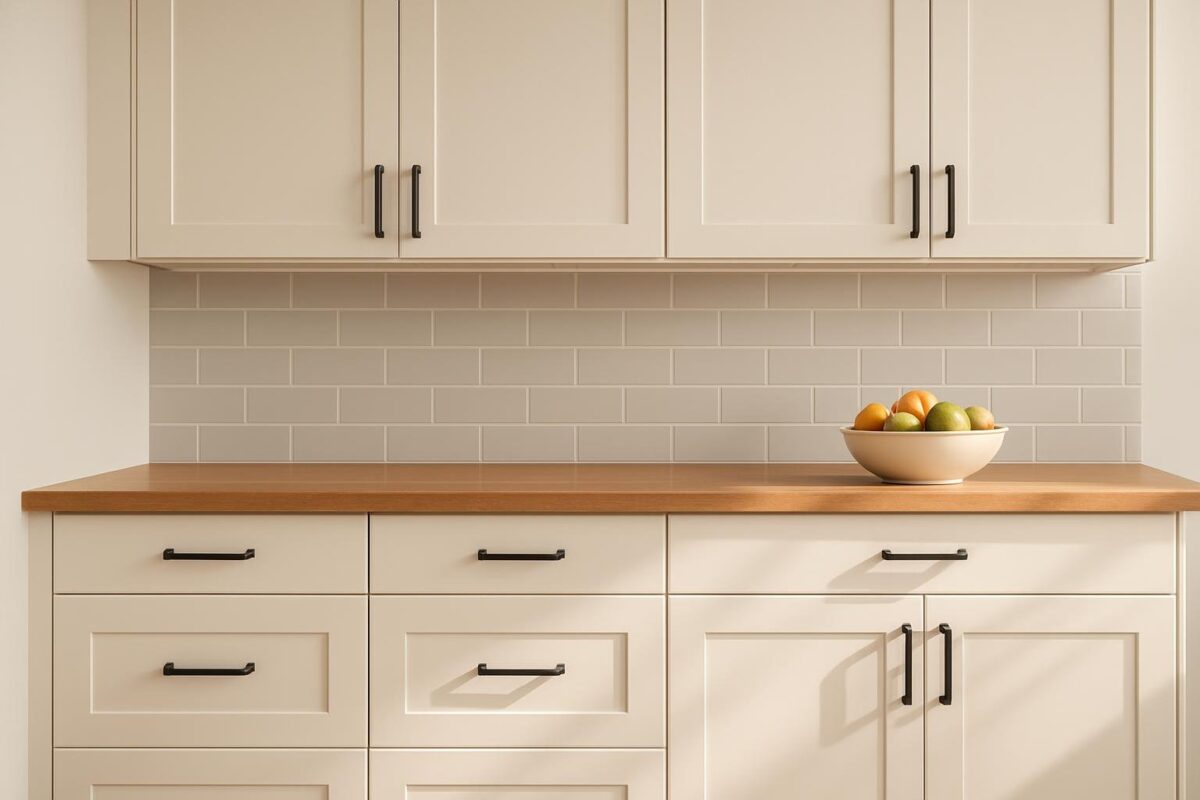Alabaster kitchen cabinets balance everyday function with a refined, timeless look. Their soft white finish works across design styles, from modern to farmhouse, while still offering the durability needed for daily use. They elevate a kitchen by providing both practical storage and a versatile backdrop for a range of materials, colors, and finishes.
This neutral foundation makes it easy to layer in warmth with natural wood, add contrast with deep navy, or highlight elegance with marble and granite. The adaptability of alabaster ensures that cabinets stay relevant as trends shift, while still creating a bright and inviting atmosphere.
Design choices such as brass hardware, pendant lighting, or a contrasting island finish can transform alabaster cabinetry from simple to striking. With the right pairings, these cabinets serve as the anchor for kitchens that feel both functional and elevated.
Butcher Block Warmth Meets Alabaster Cabinets
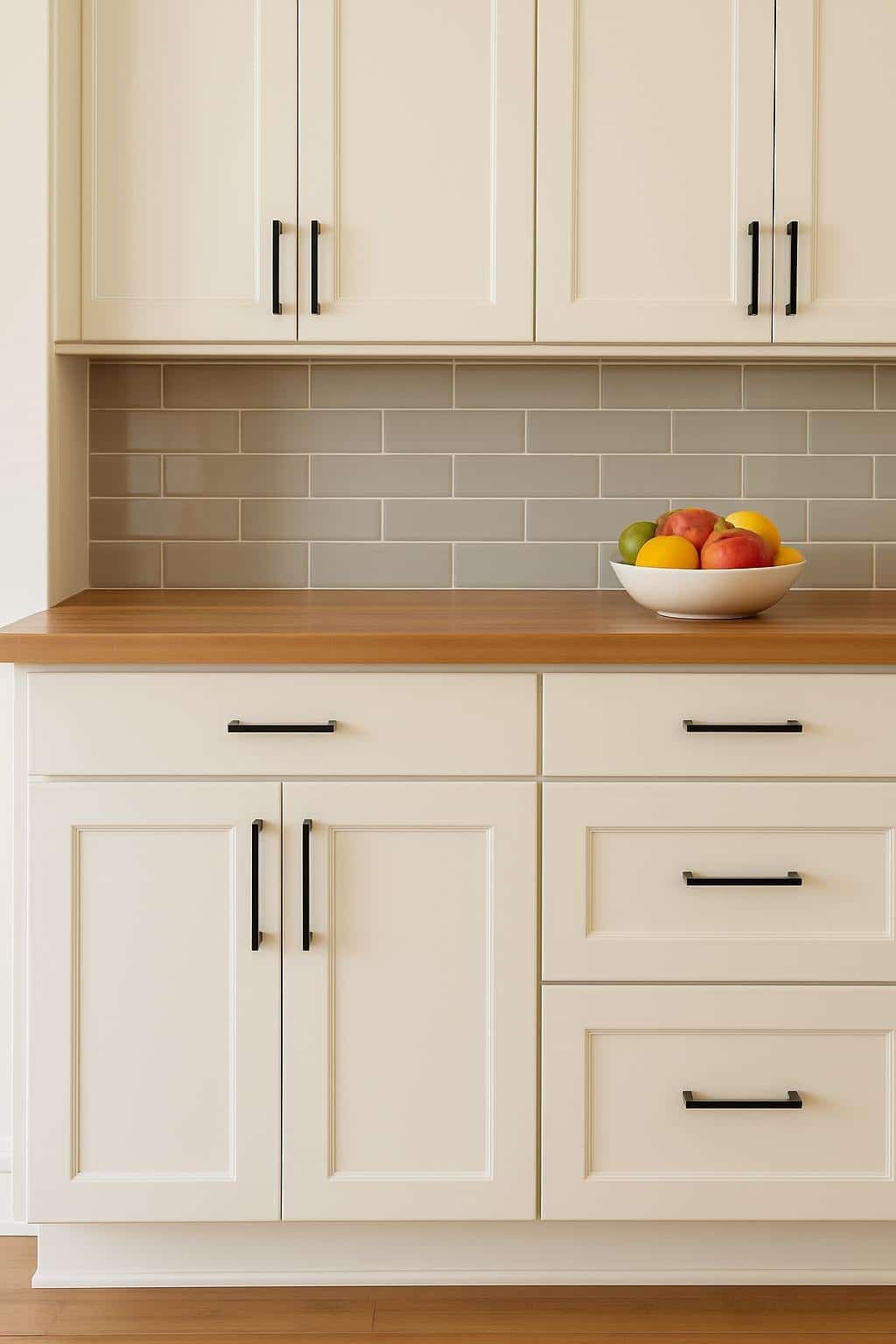
Pairing alabaster cabinets with butcher block introduces natural warmth, crisp contrast, and subtle depth into the kitchen. The combination balances light tones with organic texture, while details such as hardware and lighting conditions influence how the space feels throughout the day.
Butcher Block Counters Add Organic Warmth
Butcher block countertops bring a tactile, natural element that complements alabaster’s soft white finish. The wood grain introduces variation in tone and pattern, preventing the cabinets from appearing flat or sterile.
Different wood species create different effects.
- Maple or birch: light and subtle, blending seamlessly with alabaster.
- Walnut or oak: darker, offering stronger contrast and a richer appearance.
The warm undertones of alabaster harmonize with these woods, creating a kitchen that feels welcoming without overwhelming the eye. Unlike stone or quartz, butcher block develops a patina over time, which adds character and depth to the design.
Maintenance is straightforward but important. Regular sealing or oiling keeps the surface durable and prevents staining. Many homeowners appreciate how the natural material softens the overall look of the space while still providing a functional work surface.
Black Hardware Sharpens The Look
Hardware choices influence how alabaster cabinets and butcher block interact visually. Black pulls and knobs create crisp definition against the creamy white finish, outlining cabinet doors and drawers with clean contrast.
This contrast works especially well with butcher block, as the darker hardware echoes the natural variations in wood grain. The result is a cohesive look that feels intentional rather than busy.
For a consistent approach, homeowners often extend black finishes to faucets, light fixtures, or even window frames. This repetition creates balance and prevents the hardware from feeling like an isolated accent.
Matte black finishes tend to work best, as they provide depth without reflecting too much light. The finish also resists fingerprints more effectively than polished metals, keeping the kitchen looking tidy with less effort.
Afternoon Sunlight Highlights Soft Tones
Lighting conditions affect how alabaster cabinets and butcher block appear throughout the day. In the afternoon, natural sunlight often enhances the subtle warmth in both materials.
The creamy undertones of alabaster become more noticeable, while the butcher block surface glows with richer golden tones. This shift creates a layered, comfortable atmosphere that feels different from the cooler look of morning light.
Positioning matters as well. South- and west-facing kitchens receive warmer afternoon light, which emphasizes the natural qualities of wood and paint. In these spaces, alabaster appears softer rather than stark, avoiding the sterile look some whites can create.
Pairing this lighting effect with neutral wall colors or soft white backsplashes helps maintain balance. The combination ensures that as the light changes, the kitchen retains a cohesive and inviting appearance without drifting too far toward yellow or overly warm tones.
Navy Island With Brass Details
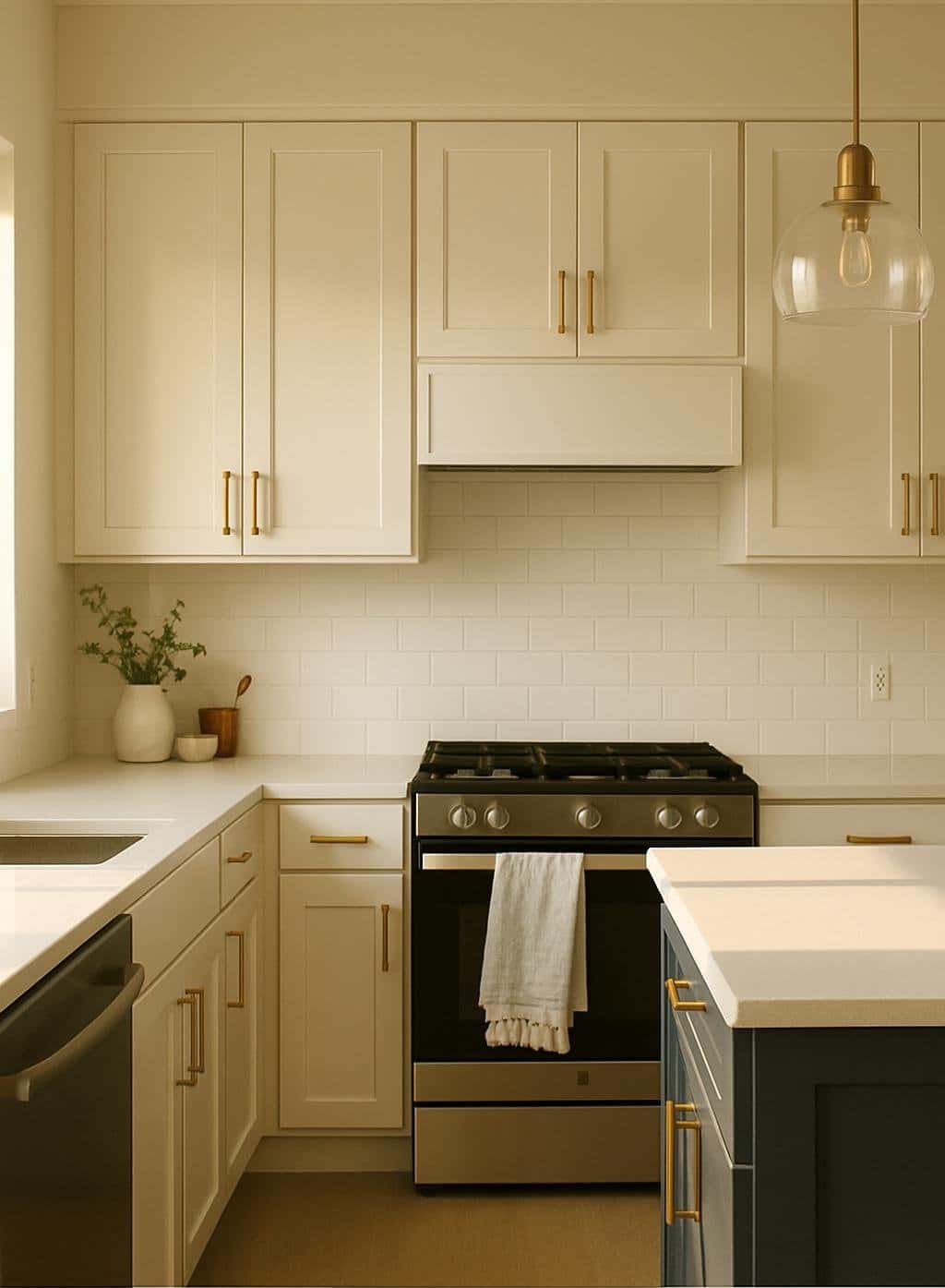
A navy island can anchor a kitchen by introducing depth and contrast, while brass details refine the look with warmth and subtle shine. The pairing works especially well with alabaster cabinets, balancing light and dark tones in a way that feels both practical and visually appealing.
Navy Island Creates Bold Contrast
A navy island stands out against alabaster cabinetry by providing a darker focal point in the room. The contrast helps define the workspace and prevents the kitchen from looking overly uniform.
Designers often use navy because it pairs well with both warm and cool materials. Wood floors, white quartz counters, and stainless appliances all complement the richness of navy without clashing.
The island also serves a functional role. With seating on one side and storage on the other, the darker finish hides scuffs and wear more effectively than lighter tones. This makes it a practical choice for families who use the island daily.
Key advantages of a navy island:
- Strong visual anchor in open layouts
- Hides everyday wear better than lighter finishes
- Works with multiple design styles: farmhouse, coastal, or modern
Brass Hardware Adds Elegance
Brass hardware introduces a warm metallic accent that softens the boldness of navy. Handles, knobs, and even light fixtures in brushed or satin brass create a balanced look that feels refined without being flashy.
Unlike chrome or nickel, brass has a muted glow that pairs well with both alabaster and navy. The finish also complements natural wood tones, making it versatile across different kitchen designs.
Brass details can be applied selectively. For example:
- Cabinet pulls on the island for a cohesive look
- Pendant lights above the island for visual repetition
- Faucet finishes to tie the space together
This layered approach ensures the brass accents feel intentional rather than overwhelming.
Golden Hour Light Enhances Richness
Natural light plays a significant role in how navy and brass appear throughout the day. During the late afternoon, when sunlight casts a warmer hue, navy surfaces gain depth while brass details reflect a soft golden tone.
This interaction enhances the richness of the materials and makes the space feel more dynamic. Artificial lighting can mimic this effect, but the subtle variation of natural light brings out the best in the finishes.
Positioning the island near windows or under skylights maximizes the benefit. Homeowners often notice that the island becomes the most visually engaging feature in the room during these hours.
The combination of navy, brass, and warm light underscores the balance between function and design, ensuring the island remains both practical and visually appealing.
Cloudy Daylight On Marble Counters
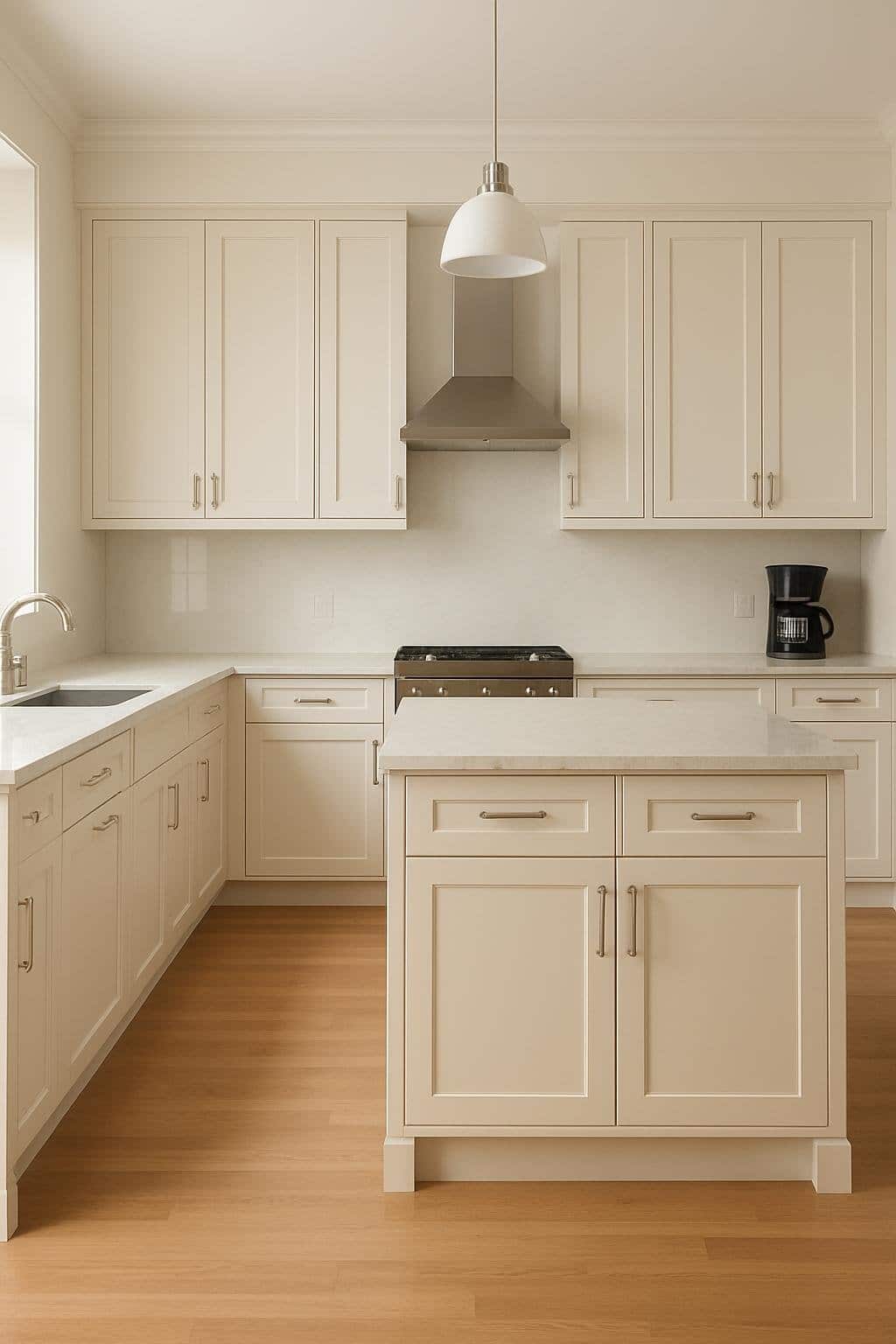
Natural light changes how surfaces appear throughout the day, and marble responds especially well to softer daylight. Subtle shifts in tone, texture, and reflection create a balanced environment that works well with warm cabinet colors like Alabaster.
Marble Counters Keep The Look Refined
Marble stands out for its veining, which introduces contrast without overwhelming the space. In kitchens with Alabaster cabinets, the stone’s cool undertones prevent the room from leaning too warm or flat.
A polished finish reflects more light, while a honed finish offers a muted surface with less glare. Both finishes can be used effectively, but the choice depends on whether the homeowner prefers crisp reflections or a softer matte appearance.
Maintenance is an important factor. Marble is more porous than quartz or granite, meaning it requires sealing to minimize staining. Regular care ensures the counters retain their refined look without becoming high-maintenance.
Common marble options with Alabaster cabinets:
- Carrara: soft gray veining, subtle contrast
- Calacatta: bolder veining, higher variation
- Statuario: clean white background, dramatic lines
Each option changes how the kitchen feels, from understated to more statement-driven.
Chrome Fixtures Add Shine
Chrome fixtures introduce a reflective element that pairs well with marble’s surface. Their polished finish catches daylight and artificial light, creating small points of brightness across the kitchen.
Unlike brushed nickel or matte black, chrome maintains a crisp, mirror-like quality. This makes it effective for balancing the softer tones of Alabaster cabinets and the natural variation in marble.
Chrome is also practical. It resists corrosion and is easy to clean, which suits a busy kitchen. When paired with marble counters, chrome handles, faucets, and lighting help unify the design without competing for attention.
Examples of chrome applications:
- Pull-down kitchen faucet
- Cabinet pulls and knobs
- Pendant light fixtures above an island
These elements work together to keep the look cohesive and polished.
Cloudy Daylight Softens The Palette
Daylight filtered through clouds reduces harsh shadows and glare. In kitchens with Alabaster cabinets, this lighting condition helps the marble counters appear more even in tone.
Instead of looking stark, the stone takes on a smoother, blended quality. Gray veining appears less sharp, and the white base of the marble feels warmer next to the off-white cabinetry.
This effect is especially noticeable during late morning or early afternoon when indirect light fills the room. It creates a neutral backdrop that makes small design details—like chrome fixtures or subtle cabinet profiles—more visible.
A simple comparison shows the difference:
| Lighting Condition | Marble Appearance | Cabinet Effect |
|---|---|---|
| Direct Sunlight | High contrast, sharper veining | Brighter, slightly cooler |
| Cloudy Daylight | Soft contrast, muted veining | Warmer, more balanced |
This shift demonstrates how natural light can change the overall perception of materials without altering the design itself.
Granite Drama With Evening Pendants
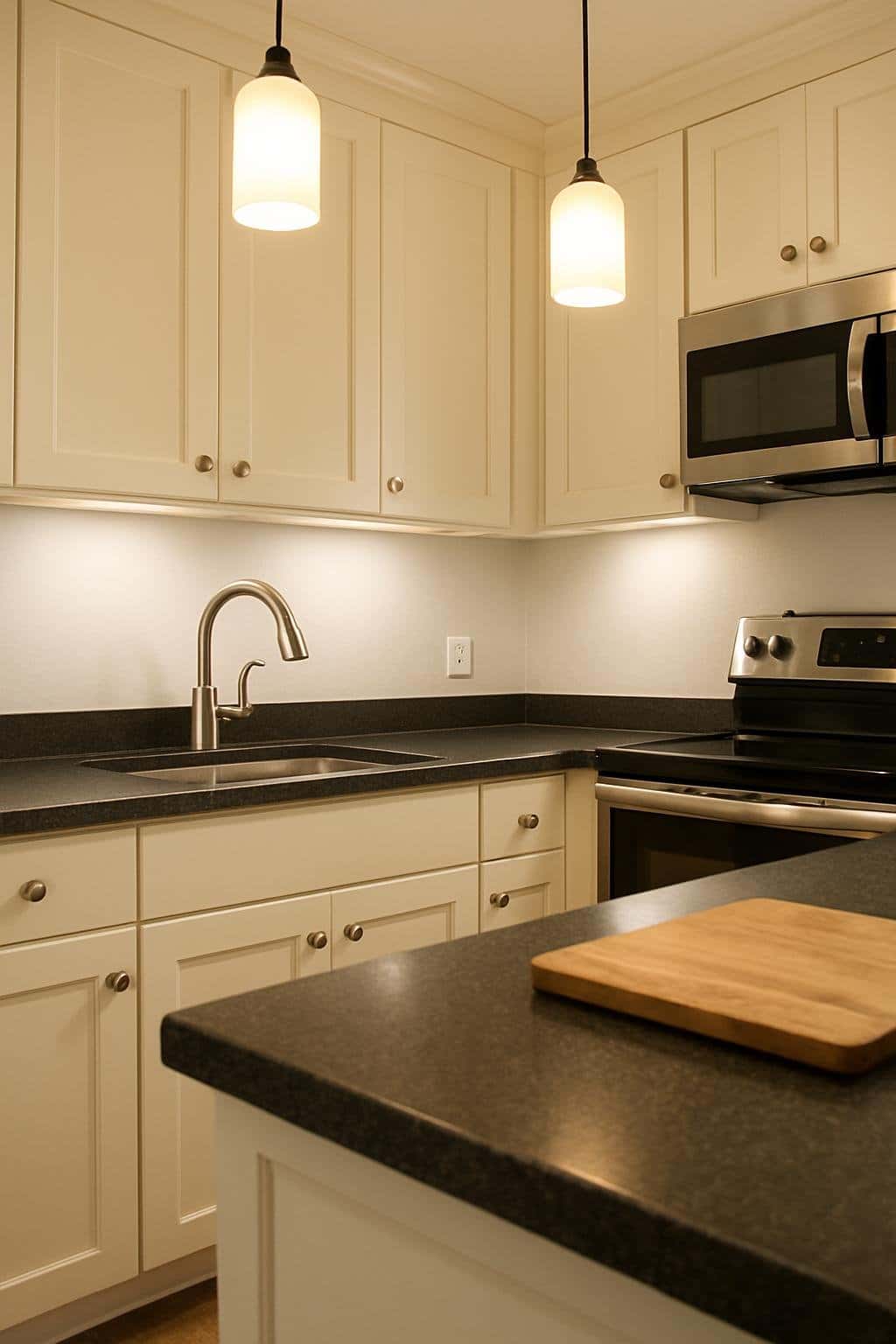
Granite surfaces, sleek appliances, and well-placed pendant lighting can shift a kitchen from simple utility to refined practicality. Each element influences how the space functions daily while also shaping its character.
Dark Granite Adds Depth And Contrast
When paired with alabaster cabinets, dark granite countertops establish a clear visual boundary between surfaces. The lighter cabinetry keeps the room open, while the darker stone grounds the design. This balance prevents the space from feeling washed out.
Granite options such as Absolute Black, Black Pearl, or Steel Gray work especially well. Their subtle patterns add interest without overwhelming the warm undertones of alabaster.
Key benefits of dark granite in this setting include:
- Strong contrast that defines work zones
- Durable surface for heavy use
- Easy maintenance with proper sealing
This combination suits both small and large kitchens. In compact layouts, the contrast helps cabinets stand out without making the room feel smaller. In larger kitchens, the darker granite adds weight and structure to expansive surfaces.
Stainless Steel Appliances Modernize The Space
Stainless steel appliances complement alabaster cabinets by introducing a cooler tone that balances the warmth of the cabinetry. The reflective finish also pairs smoothly with granite, preventing the overall palette from leaning too heavy or too soft.
Refrigerators, ovens, and dishwashers in stainless steel provide a consistent look across the kitchen. The finish resists staining and is easy to clean, which supports everyday function.
Pairing tips:
- Match appliance handles with cabinet hardware for continuity
- Use brushed stainless finishes to reduce visible fingerprints
- Combine with subtle backsplash colors like pale gray or soft blue for cohesion
This approach creates a kitchen that feels updated without appearing overly trendy. The mix of warm cabinets, dark granite, and cool steel strikes a practical balance that lasts.
Evening Pendant Lights Create Cozy Drama
Pendant lights placed above islands or counters provide both task lighting and a sense of atmosphere. With 13-foot ceilings, rods or chains may need to extend about 60–65 inches so the light hangs at a practical height.
Warm-toned finishes such as champagne bronze or brushed brass complement alabaster cabinetry. These metals echo the warmth of the cabinets while standing out against the darker granite.
Practical placement considerations:
- Hang pendants 30–36 inches above the countertop
- Space fixtures 24–30 inches apart for even coverage
- Choose dimmable bulbs to adapt brightness throughout the day
The result is a kitchen that feels functional during meal prep but shifts into a softer, more inviting atmosphere in the evening. This layered lighting ensures the space adapts to different needs without sacrificing clarity or comfort.
Golden Hour Glow On A Warm Island
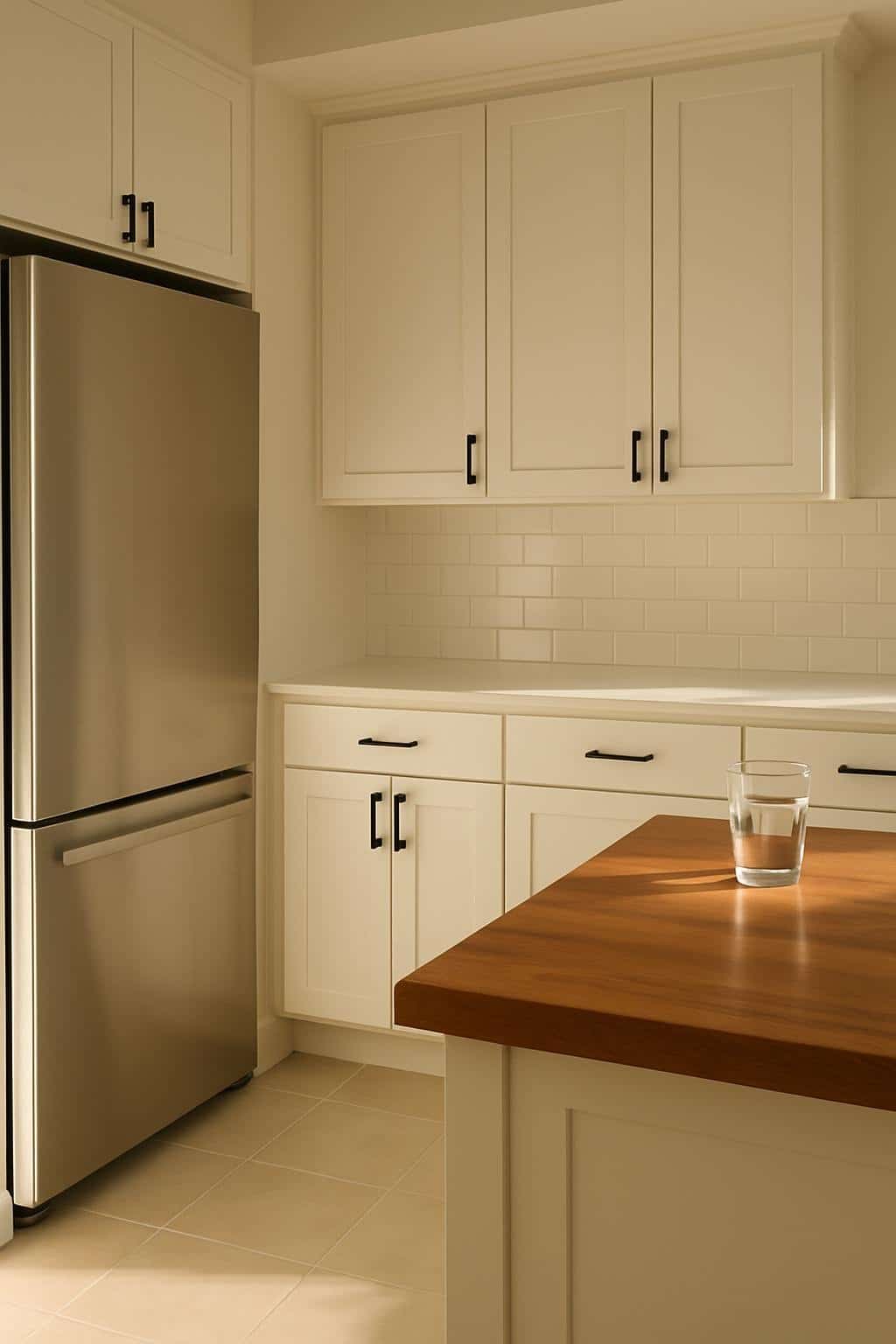
A kitchen with alabaster cabinets gains depth and balance when paired with natural textures, dark accents, and thoughtful lighting. The right combination of materials and finishes shapes how the space feels and functions throughout the day.
Butcher Block Island Adds Rustic Warmth
A butcher block countertop on the island introduces natural grain and texture that contrasts with the smooth finish of alabaster cabinets. The wood surface softens the brightness of the cabinetry, creating a warmer and more approachable feel.
Homeowners often choose maple, oak, or walnut for durability and variation in tone. Each species offers a different character, from lighter golden hues to deeper brown shades. This makes it easy to match the island with flooring or other wood accents.
Maintenance is straightforward when sealed properly. Regular oiling protects the surface from stains and keeps the wood looking fresh. Unlike stone, it can also be sanded and refinished if scratches occur, extending its lifespan.
A butcher block island also serves as a functional prep space. Its forgiving surface is ideal for chopping, rolling dough, or even serving as a casual dining spot. This combination of practicality and warmth makes it a strong complement to alabaster cabinetry.
Black Hardware Grounds The Cabinetry
Black hardware provides a crisp contrast against alabaster cabinets, preventing the design from appearing too soft or washed out. Handles, knobs, and pulls in matte or satin black stand out clearly, giving the cabinetry definition.
The dark hardware also ties in well with other black elements, such as light fixtures, appliances, or window frames. This creates a sense of cohesion across the kitchen without overwhelming the softer tones of the cabinets.
Hardware placement affects both function and appearance. Larger pulls on drawers improve usability, while smaller knobs on upper cabinets maintain balance. Choosing a consistent style across all doors and drawers helps the design feel intentional.
For homeowners concerned about fingerprints or wear, powder-coated finishes provide durability. This ensures that the hardware maintains its clean look even with daily use, reinforcing both function and style.
Golden Hour Glow Creates Welcoming Atmosphere
Natural light during the golden hour highlights the warmth of alabaster cabinets and wood accents. The soft, angled sunlight enhances the creamy undertones of the paint, making the space feel more inviting.
This effect is especially noticeable on the island, where the wood surface reflects the warm light. The glow adds depth to the material, emphasizing its natural grain and variation.
Strategic lighting placement extends this effect beyond sunset. Pendant lights above the island with warm-toned bulbs replicate the same soft glow, ensuring the kitchen maintains its welcoming atmosphere in the evening.
By combining natural and artificial light sources, the space shifts seamlessly from day to night. The result is a kitchen that feels comfortable at all hours, with alabaster cabinetry and wood elements working together to reflect and diffuse light effectively.
Closing
Alabaster kitchen cabinets provide a soft, neutral finish that works well with a wide range of design styles. Their warm undertone makes them adaptable, whether paired with modern hardware or traditional wood accents.
They are valued for both appearance and durability. Many homeowners choose all-wood construction with features like soft-close drawers and full-extension glides, which improve daily use.
When paired with the right surroundings, alabaster cabinets can create balance. For example:
| Complementary Element | Works Well With Alabaster |
|---|---|
| Countertops | Grey, ivory, or black |
| Hardware | Matte black, brushed nickel |
| Wall Colors | Cool greys, soft neutrals |
This flexibility allows them to fit into small kitchens, open layouts, or utility spaces like laundry rooms. Their light tone reflects natural light, helping rooms feel brighter without being stark.
Maintenance remains straightforward. A non-abrasive cleaner and soft cloth are usually sufficient to keep the finish looking fresh.
By combining practical storage solutions with a timeless finish, alabaster cabinets continue to be a reliable option for everyday living. They balance function with style in a way that adapts to changing needs over time.

